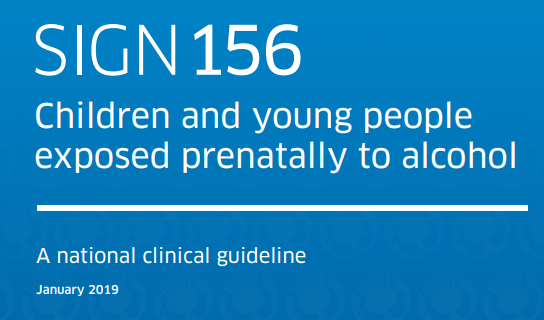Children and young people exposed prenatally to alcohol
Alcohol consumption in pregnancy has the potential to cause significant fetal damage. In 1973, a cluster of birth defects resulting from prenatal alcohol exposure (PAE) was first described as the clinical entity fetal alcohol syndrome (FAS). Diagnostic criteria for FAS include evidence of PAE, evidence of structural or functional central nervous system abnormalities,
a specific pattern of three facial abnormalities and growth impairment (either prenatally, after birth or both). Exposure to alcohol during pregnancy can result in other fetal injuries. These wider patterns of effects, along with FAS, constitute the continuum of structural anomalies and neurocognitive and behavioural disabilities associated with prenatal exposure to alcohol which has been labelled FASD.
In Scotland, alcohol consumption in women of childbearing age is common and is recognised as a significant public health issue. It is estimated that approximately 3.2% of babies born in the UK are affected by fetal alcohol spectrum disorder (FASD), which is three to four times the rate of autism, meaning that as many as 172,000 people could be affected by the disorder in Scotland. A recent study in Glasgow studied the meconium of newborn babies and found that 42% of samples showed evidence of the mother having consumed alcohol during pregnancy, with 15% of those pregnancies exposed to very high levels of alcohol.
Remit and target users
This guideline provides evidence-based recommendations on measurement of alcohol consumption in pregnancy and consensus-based recommendations on:
- identification of children at risk of FASD
- criteria for diagnosis and use of FASD as a descriptor
- the medical assessment
- physical examination
- sentinel facial features
- neurodevelopmental assessment
- the multidisciplinary assessment team
- special considerations in the neurodevelopmental assessment
- management and follow up of children and young people affected by PAE.
Detailed treatment options for individuals affected by PAE are not included.
The guideline will be of interest to individuals involved in the assessment and diagnosis of people at risk of FASD, including child development specialists, clinical and educational psychologists and neuropsychologists, clinical geneticists, general practitioners and members of the primary care team, health visitors, judicial services, midwives, neonatologists, nurses (eg school, learning disability and others), obstetricians, occupational therapists, paediatricians, physicians, physiotherapists, psychiatrists, social workers and speech and language therapists. It will also be of interest to people at risk of FASD, their parents and carers, adoptive and fostering services, supportive organisations in the voluntary sector and policy makers.
How this guideline was developed
This guideline was developed using a combination of standard SIGN methodology, based on a systematic review of the evidence, and adaption of the Canadian guideline for diagnosis of FASD. Further details on the processes used are included in the guideline.
Keeping up to date
This guideline was first issued in 2019 and revalidated in 2022. Details can be found in the scoping report. Review of the ethical, legal and social implications of this guideline will be included in the 2024/25 SIGN guideline programme. Other revisions to the guideline will be considered out of scope. The review history, and any updates to the guideline in the interim period, are noted in the review report.
![]() Current 3-7 years
Current 3-7 years
Some recommendations may be out of date, declaration of interests governance may not be in line with current policy.
ISBN 978 1 909103 67 2

Guideline
Supporting Material
- Scoping report 2022 (PDF)
- Declarations of interest (PDF)
- Search Narrative (PDF)
- SIGN Copyright request (PDF)
- A rapid synthesis of qualitative studies (PDF)
- Information about FASD (PDF)
- Information for individuals receiving assessment (PDF)
- Information for clinicians - during assessment (PDF)
- Information for clinicians - after assessment (PDF)
- Neurodevelopmental areas of assessment (PDF)
- UK-WHO growth chart: boys 0-4 (PDF)
- UK-WHO growth chart: girls 0-4 (PDF)
- UK growth chart: boys 2-18 (PDF)
- UK growth chart: girls 2-18 (PDF)
- Diagnostic algorithm for FASD (PDF)
- Sample FASD assessment form
- Sample FASD diagnostic assessment summary
- Sample FASD management plan